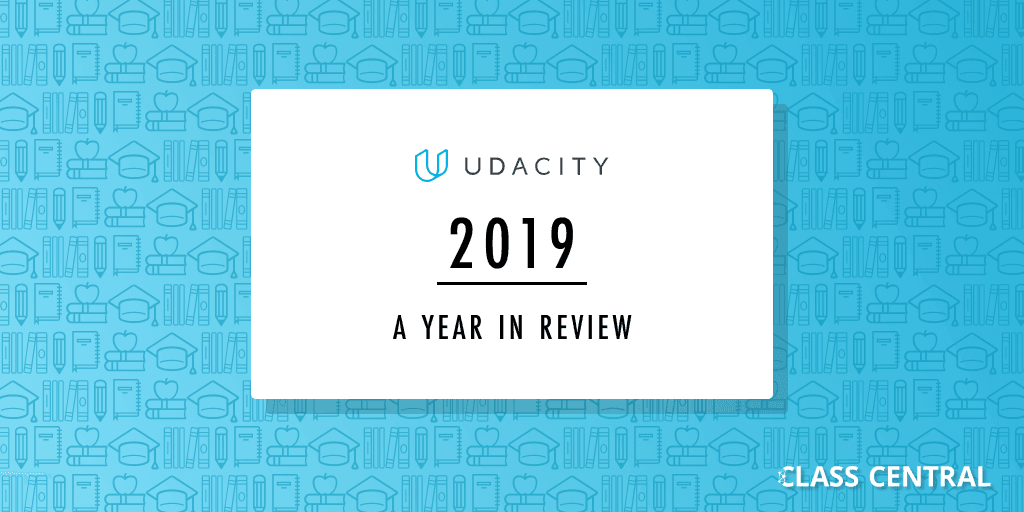Udacity’s 2019: Year in Review
Layoffs, price hikes, and a new CEO: 2019 was an eventful year for Udacity.
2019 was an eventful year for Udacity. After a lackluster 2018 — plagued by underwhelming growth, a decrease in paid enrollments, and a lack of blockbuster Nanodegrees — Udacity needed to react strongly to steady the ship.
The reaction began in late 2018 with the return of Sebastian Thrun to the helm of the company following the departure of Vishal Makhijani. Thrun’s return marked the beginning of a drastic restructuring plan designed to put Udacity back on track to profitability.
Udacity updates its tagline almost every year. In 2019, they went back to their 2016 tagline: “Be in demand.” But if we had to condense Udacity’s 2019 in a single sentence, we’d go with “Doing more with less.” To understand why, keep reading. For previous years’ recaps, follow the links:
By the Numbers
| 2017 | 2018 | 2019 | |
| Revenue | 70 million | 90 million | TBA (Early 2020) |
| Graduates | 18 thousand | 65 thousand | 100 thousand |
| Nanodegrees | 22 | 35 | 40 |
| Employees | ~500 | ~350 | ~300 |
Udacity is expecting to end 2019 with 11.5M registered users.
Highlights
Restructuring
Thrun’s restructuring plan involved an all-encompassing set of measures geared toward cutting costs, increasing revenue, and consolidating Udacity’s core product, Nanodegrees.
Layoffs
Over a period of nine months, Udacity went through three rounds of layoffs.
The first round took place in August 2018. It was one of the last major decisions enacted by Makhijani during his tenure as CEO — an early sign of the difficulties faced by the company. At the time, Udacity laid off about 25 employees, mostly from their offices in Germany.
The second round started in the wake of Thrun’s return in late 2018 and concluded in early 2019. This time, Udacity cut approximately 125 employees, mostly from their offices in Brazil.
The third round took place in April 2019. In this final round, Udacity laid off about 75 employees.
| Period | Layoffs |
| Aug 2018 | 25 |
| Feb 2019 | 125 |
| April 2019 | 75 |
Overall, by mid-2019, Udacity’s 500-employee-strong workforce had shrunk to around 300.
In less than a year, Udacity parted with over 40% of its staff.
But departures haven’t been limited to layoffs, with some Udacity instructors leaving the company of their own accord.
https://twitter.com/MatDrinksTea/status/1114206848842731521
This week I had my last day at @udacity. In the past few years, I have met so many creative educators, colleagues, and friends. I'll continue to teach machine learning in a different context, so stay tuned! And I am excited to have more to do (and, always, to learn)
— Cezanne Camacho (@cezannecam) June 6, 2019
https://twitter.com/parnianbarekat/status/1123718191883145217
Price Hikes
In 2019, Udacity changed its monetization model, effectively doubling its Nanodegree prices.
Nanodegrees used to cost a flat fee: you’d pay a fixed amount to access a Nanodegree for a given number of months. But in May 2019, Udacity switched to a subscription model: you pay $399 per month to access a Nanodegree.
Udacity framed the change as a positive, allowing learners to save money by finishing their Nanodegrees more rapidly. However, by Udacity’s own account, most Nanodegrees take between three and four months to complete. This translates into an effective cost of between $1,200 and $1,600 per Nanodegree — about twice what they used to cost in early 2019.
Udacity has continued to tweak its pricing model. As of October 2019, instead of paying $399 for one-month access, learners may pay upfront for several months and get a discount. So Udacity replaced flat fees with subscriptions, only to bring flat fees back six months later.

The 2019 price increase is compounded by the fact that in 2018, prices had already doubled or even tripled. Consider for instance the evolution of the flat cost of the Introduction to Programming Nanodegree:
| Period | Cost & Duration | Cost / Month |
| Mid 2018 | $399 (5 months) | $80 |
| Late 2018 | $599 (3 months) | $200 |
| Late 2019 | $1,436 (4 months) | $360 |
So in a little over a year, the cost of the Introduction to Programming Nanodegree increased by 350%. And so did the cost of many other Nanodegrees.
But Udacity’s price tweaks seem to go further. Some learners report seeing different prices depending on which computer they’re using, and on whether they’re logged into Udacity or not:
https://twitter.com/mkupsmth/status/1203847239531028480
These price hikes and experiments denote urgency and suggest financial struggle. Udacity hasn’t raised funds since 2015, and in early 2019, Thrun stated that the company’s “trajectory was not long-term tenable.” 2020 is probably going to be a pivotal year for Udacity.
Nanodegrees
In 2019, Udacity launched more Nanodegrees than ever before, but they also retired a few.
In last year’s analysis, Dhawal Shah, Class Central’s CEO, noted that none of Udacity’s 2018 Nanodegrees were big hits. Thrun would later echo this sentiment, partly attributing the company’s bad spell to a lack of blockbusters.
To address this issue, Udacity changed its approach to Nanodegree creation. Nanodegrees are now developed by smaller, leaner content-creation teams capable of producing Nanodegrees more quickly and at a fraction of their previous cost.
This new approach has allowed Udacity to speed up Nanodegrees rollout. Udacity released 14 new Nanodegrees in 2019 (5 more than in 2018):
- C++ Nanodegree
- Data Engineer Nanodegree
- Marketing Analytics Nanodegree
- Data Structures and Algorithms Nanodegree
- Data Engineering Nanodegree
- Data Visualization Nanodegree
- AI Product manager Nanodegree
- Sensor Fusion Engineer Nanodegree
- Cloud Developer Nanodegree
- Cloud DevOps Nanodegree
- Java Developer Nanodegree
- UX Designer Nanodegree
- Data Streaming Nanodegree
- Intel Edge for AI Nanodegree
In addition, they updated some of their bestsellers, including the Front-End, Full-Stack, and Machine Learning Nanodegrees. But they also retired a few programs, including their Virtual Reality Nanodegrees. And they cancelled or postponed others, such as their Cybersecurity Nanodegree.
Udacity currently offers 40 Nanodegrees.
Mentors
In 2019, Udacity hired new Mentors and expanded their role, but not their pay.
While they were laying off several hundred full-time employees on the one hand, they were recruiting several thousand part-time Mentors on the other. Mentors support learners during their Nanodegree. They used to do this collectively, via community chat rooms. But since mid-2019, Mentors also offer one-on-one support, in a bid to increase graduation rates.
But the new mentorship model arrives in the wake of pay cuts to Udacity Mentors, which seems to reflect the overarching theme of Udacity’s 2019: doing more with less. Indeed, in 2019, Udacity:
- Expanded student support while lowering Mentors’ pay.
- Accelerated Nanodegrees rollout while laying off content creators.
- Increased Nanodegree prices while spending less money producing them.
These forces seemingly pulling in opposite directions raise an important question:
Can Udacity cut costs and employees while maintaining quality and learner satisfaction?
Other
In 2019, Udacity showed other symptoms of going through a dry spell:
- Cancelling Intersect: Udacity didn’t organize its annual conference, Intersect — a first since the conference was inaugurated in 2016.
- Sunsetting app: Udacity retired its official mobile app from the App Store and Google Play.
- Closing offices: Udacity closed or downsized several of its offices worldwide, including its São Paulo office, in Brazil.
Results
Thrun only retook the reins of Udacity on an interim basis. His restructuring plan was implemented as a short-term response to the company’s downturn. To carry the company in the long run, Gabriel Dalporto was appointed CEO of Udacity in August 2019.
New CEO
Dalporto joined Udacity after an eight-year stint at LendingTree, an online lending marketplace where he served in various leadership positions. Now head of Udacity, his role is to formulate and orchestrate the company’s long-term strategy.
So far, this strategy has remained largely unchanged, with Dalporto emphasizing efficient Nanodegrees rollout through cost-effective production and price-conscious decisions. However, he’s also considering new strategies, such as partnering with universities and expanding the enterprise business — for instance, in India, where Udacity just doubled its staff.
Top Nanodegrees
According to Udacity, the company’s most popular Nanodegrees in 2019 were the:
- Data Engineering Nanodegree
- Machine Learning Nanodegree
- Intro to Programming Nanodegree
Interestingly, the ranking is topped by one of Udacity’s newer Nanodegrees. And the second Nanodegree was updated this year. This confirms that novelty is key to attract new learners. However, the third Nanodegree is one of Udacity’s oldest, which illustrates why Udacity is so keen on finding its next big hit: a Nanodegree that will continue to perform well long after its novelty has faded.
Free Courses
In 2019, Udacity launched 7 free courses, down from 35 in 2018. This drastic drop emphasizes Udacity’s focus on paid content, and it further distances the company from its roots as one of the world’s major open course providers.
| 2013 | 2014 | 2015 | 2016 | 2017 | 2018 | 2019 |
| 12 | 31 | 64 | 49 | 34 | 35 | 7 |
Graduations
In an email to Class Central, Udacity states having reached 100 thousand Nanodegree graduates in 2019, up from 65 thousand in 2018. Although encouraging, this metric has to be considered in light of others such as revenue, which Udacity plans to share in early 2020.
Scholarships
In 2019, Udacity announced four scholarship programs.
Scholarships give learners a chance to earn a free spot in a Nanodegree. Each scholarship focuses on a different subject, is sponsored by a different industry partner, and may lead to a different Nanodegree.
| Scholarship | Partner | Nanodegrees Funded |
| Data Science | Bertelsmann | 1,600 |
| Secure & Private AI | 300 | |
| DeepRacer | Amazon Web Services | 200 |
| Edge AI | Intel | 750 |
This article is just one of our 2019 MOOC Roundup Series. Find the whole series here. You’ll discover everything about MOOCs in 2019 — from the most popular classes, to overviews of MOOC platforms developments, to looking at the future of MOOCs.








Dimitrios Tosidis
Hello Manoel Cortes Mendez, I am a mentor at Udacity and this article is very enlightening. You have collected great statistics. Could you share also statistics about the mentors, because as I read your article for the mentors, you just share your thoughts.
Name
Could you share pass rates? I am on Intro to Programming and am really struggling with Java and Python projects. For Python the mentor is very helpful but the project (RPS) is very tough, for JS unresponsive. I have a week left and will not pass.
Dominic Milburn
I was led to believe that the quality of the course would be very good. I can’t believe how wrong I was! I have no idea where they hired the instructors for this course but they are rubbish. They make assumptions about your knowlege when you get first introduced to a topic and the refer to concpets that get introduced later in later lesson with out highlighting it. The lesson plans are dreadful, throughout the entire course they have jump form one subject to the next without a overall central theme running through the course. it is just a bunch of lessons that they have suck together.
It is not just the instructors that are bad, there are mistakes everywhere and the overall quality is really poor. The cloud platform they provide does not have all the permissions and service you need for the exericses. There are referance to resources files that don’t exist and then when the resources files there are mistakes and typos so the exercise you are doing does not work and oyu have no idea why.
I have lost count of how many support tickets I have logged in a effort to highlight lack of quality only to find that I’m ignored.
One of the unquie selling points the community chat but you find that the majority of the sutdents in the chat rooms are complaining about the quality of the course.
Do not be suckered by these snake oil salesman. Go find another online learning course elsewhere.
I want my money back
Anonymous
it’s really ridiculous how Udacity charges 400$ per month to enroll in a ND while other competitor Online platforms offers 50$ while offering most if not all the learning features that Udacity does, it’s really not surprising that Google chose Coursera Over Udacity for its career certificates programs.